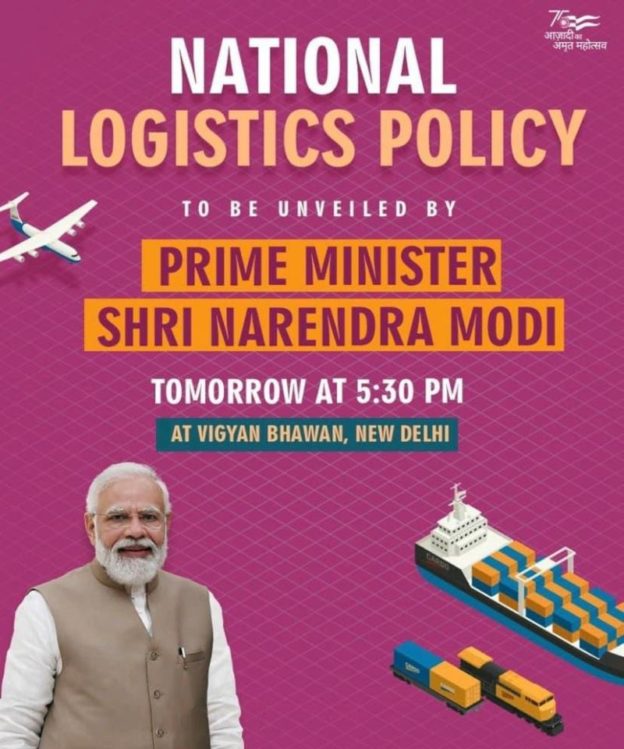Prime Minister Narendra Modi on Saturday unveiled the national logistics policy and set a goal to trim the country’s logistics costs from as much as 13-14% of its gross domestic product (GDP) to a single digit over the next few years.
Prime Minister Narendra Modi on Saturday unveiled the national logistics policy and set a goal to trim the country’s logistics costs from as much as 13-14% of its gross domestic product (GDP) to a single digit over the next few years.
The policy aims to ensure seamless movement of goods and services across the country and cut elevated logistics costs, often considered the biggest structural bottleneck for both external and internal trade in India. Touted as the first holistic framework for the country & $150-billion logistics sector, the policy is expected to help boost manufacturing, create infrastructure and spur employment.
If we want to be globally competitive, it (achieving the target) is a low-hanging fruit, the Prime Minister said, casting the policy as one of the crucial steps in India’s journey towards being a manufacturing powerhouse and a developed nation. Modi, however, was emphatic in stating the need for coordinated follow-up action by both public and private sectors to ensure that the policy serves the intended purpose.
A policy isn’t an end in itself. It’s a beginning. Policy plus performance is equal to progress. Once the policy is in place, the responsibility of the government and industry goes up; Modi said. I hope goods will move with the speed of a cheetah (due to the efficient implementation of the logistics policy). Incidentally, the PM, earlier in the day, released eight cheetahs procured from Africa in Kuno National Park in Madhya Pradesh, to re-introduce the animal which had got extinct in India.
The new logistics policy caps eight years of the government’s efforts to create a conducive ecosystem in the logistics sector, he said, adding that it will complement the PM Gati Shakti national masterplan initiative. Gati Shakti is essentially a GIS-based platform with close to 1,500 layers, capturing all utilities and network linkages in various economic clusters. Under this, different departments join hands for a coordinated development of projects.
The new logistics policy has four critical features: Integration of Digital System (IDS); Unified Logistics Interface Platform (ULIP); Ease of Logistics (ELOG); and System Improvement Group (SIG). Under the IDS, 30 different systems of seven departments are integrated; these include data of the road transport, railways, customs, aviation and commerce departments. This will lead to faster cargo movement.
The ULIP will make all available transport modes visible to stakeholders so that they can take informed decisions. Under the ELOG, rules will be simplified. The SIG will monitor all logistics projects regularly and act as a sort of bridge between the government and industry. It will enable stakeholders to raise queries and flag issues so that an inter-ministerial group can find appropriate solutions. A logistics data bank has been developed, which ensures container tracking for both export and import. Launched in July, it has already helped track about 50 million containers.
The renewed thrust on reducing logistics costs assumes significance, as the country aims to substantially raise its merchandise exports to $1 trillion by FY28 from $422 billion in FY22. According to an Arthur D Little-CII report, higher logistics cost is causing a competitiveness gap of $180 billion for India, and this will likely rise to $500 billion by 2030. According to a 2016 HSBC report, domestic bottlenecks, including high logistics costs, accounted for a half of the slowdown in the country’s exports.
As per the Economic Survey 2017-18, a 10% decrease in indirect logistics cost could lead to an export growth of 5-8%. As such, the country was ranked 44th in the World Bank’s Logistics Performance Index in 2018 (the latest available report). Poor logistics not just inflate the costs of external and internal trade but also lead to losses of commodities, especially perishable ones in transit.
Transport and highways minister Nitin Gadkari said the policy, which focuses on re-engineering, digitisation and multimodal transport, would further improve ease of doing business. The commerce and industry minister said the policy, along with PM Gati Shakti, will act as a ‘double engine’ to transform the state of the country’s logistics sector. The event was also attended by Union ministers Dharmendra Pradhan, Sarbananda Sonowal and Ashwini Vaishnaw.
Industry players hail the policy. Anshul Singhal, managing director at Welspun One Logistics Parks, said the policy will “give the much-needed impetus to India’s logistics and warehousing sector in terms of the creation of world-class infrastructure facilities, an E-handbook for warehousing standards, digitalisation and other new-era technology uses, promotion of multi-modal transport, etc”.
Anil Verma, executive director and president, Godrej & Boyce, said, the policy “is a crucial step for efficient supply-side management and reducing logistic costs to global standards of about 10%”. Ketan Kulkarni, chief commercial officer at Blue Dart, said the policy has “a special emphasis on streamlining processes for seamless coordination, employment generation and skilling, reduction in overall logistics cost, and ease of business for corporates, farmers and MSMEs”.
https://www.financialexpress.com/economy/logistics-policy-launched-to-boost-indias-trade-edge-and-seamless-movement-of-goods-and-services/2672184/





